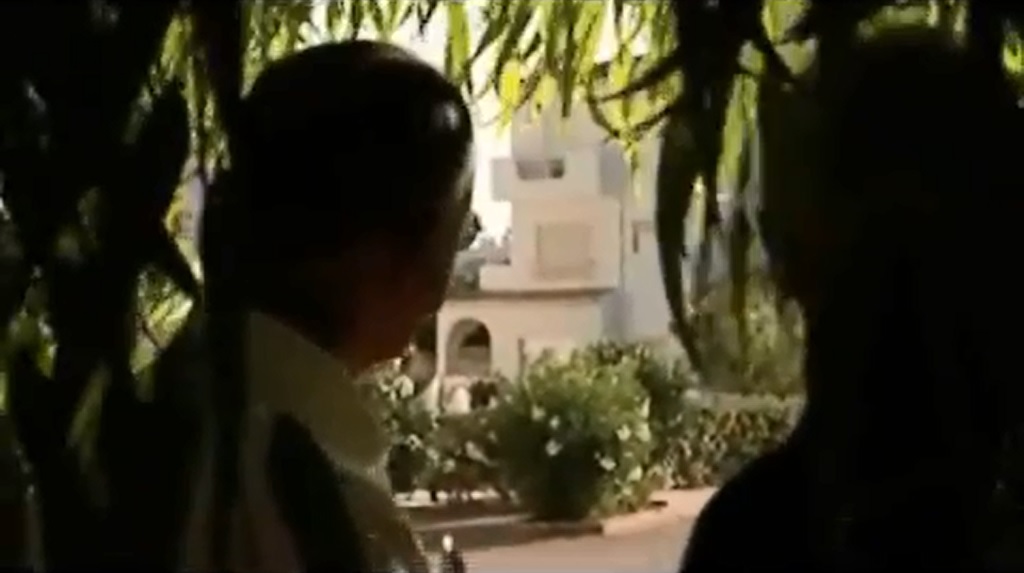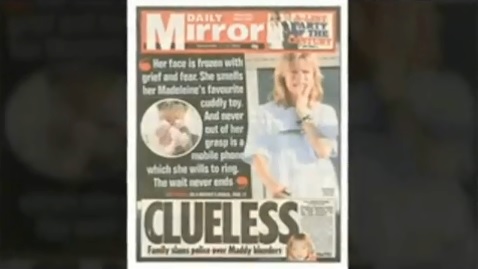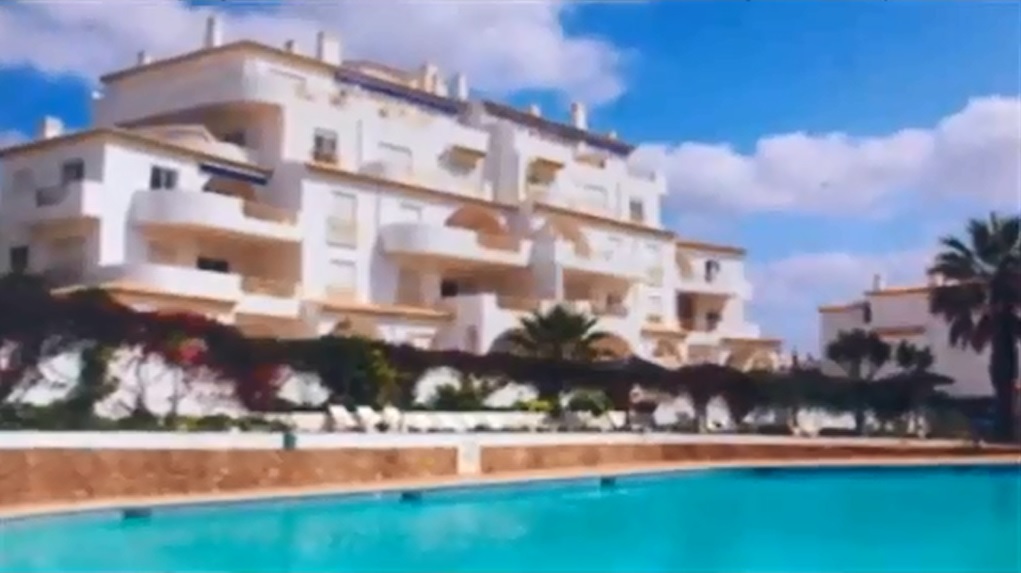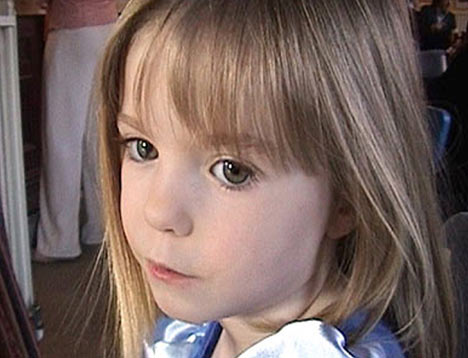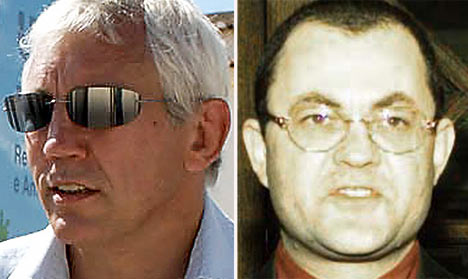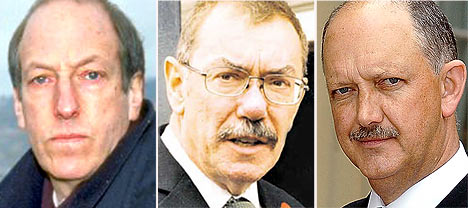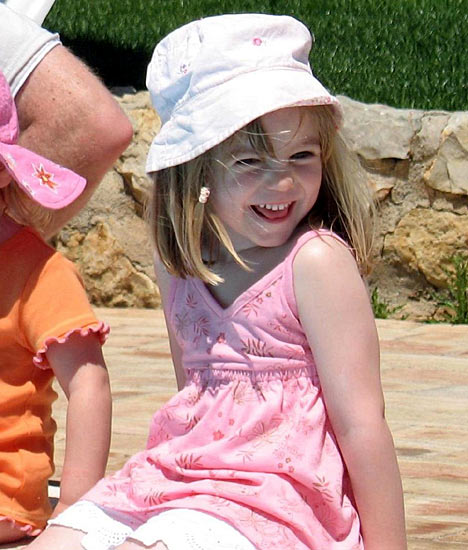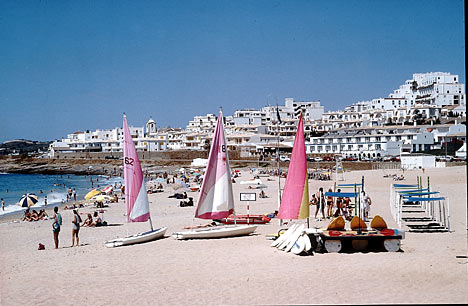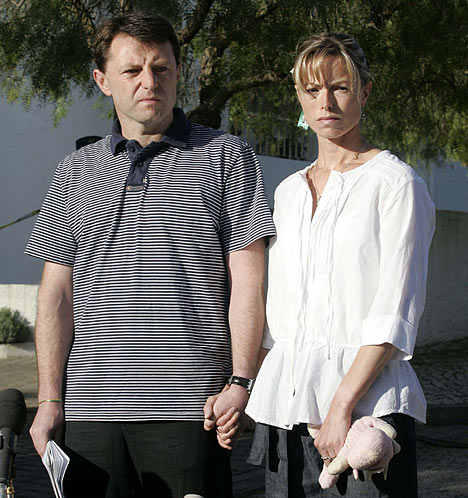Channel 4: Dispatches 'Searching For Madeleine' Transcript:
Thanks to 'kizzy' for transcription
JS = Juliet Stevenson
(Narrator)
CS = Chris Stevenson (former Detective Chief Superintendent, Cambridgeshire Police)
DB = David
Barclay (Former Head of Physical Evidence UK National Crime and Operations Faculty)
DC = David Canter (Director, Centre
for Investigative Psychology, University of Liverpool)
GL = Gary Ligg (Former Senior Search Adviser, West Yorkshire
Police)
MT = Matt Tapp (Police Media Adviser)
CP = Charlotte Pennington (Mark Warner Nanny)
DH = David
Hughes
GE = Guilhermino da Encarnação (Chief investigating officer)
GM = Gerry McCann (father of
Madeleine)
KG = Voice of Kate Garraway (presenter - GMTV)
KM = Kate McCann (mother of Madeleine)
LP = Len
Port (local journalist)
JR = Voice of Jill Renwick (family friend)
JN = Journalist (unknown)
JW = June Wright
(Luz resident)
MK = Matt King (Luz Resident)
OS = Olegário de Sousa (Spokesperson for the PJ)
TV
= voice-over on television
Red writing indicates text that appeared on screen.
PART ONE
JS: On May 3rd, 2007, 3 year old Madeleine McCann
went missing.
GM: Please, if you have Madeleine, let her come home...
JS:
168 days later, that is the only undisputable fact about this extraordinary case.
OS: I have no
facts to sustain whether the child is alive or dead...
JS: Tonight, Dispatches sends 5 leading
criminal investigators to Portugal.
CS: If we got two thumb marks then that would have to be an investigative
priority...
JS: Their brief to bring 134 years of experience to the search for Madeleine.
The Portuguese village of Praia da Luz is a quiet holiday resort, but for the last 6 months it has been at the centre of an
intense police investigation and a frenzy of media speculation. Dispatches team of criminal experts arrives in Luz intending
to shed fresh light on what might have happened to 3 years old Madeleine McCann in a case that has dominated the headlines.
[Chris Stevenson
(former Detective Chief Superintendent, Cambridgeshire Police)
Professor David Canter (Director, Centre for Investigative
Psychology, University of Liverpool)
Gary Ligg (Former Senior Search Adviser, West Yorkshire Police)
Matt Tapp (Police
Media Adviser)
David Barclay (Former Head of Physical Evidence UK National Crime and Operations Faculty)]
CS: What we're looking to do is what we would have done had this been reported in the
UK.
DC: I would really want to know an awful lot about the typical patterns of activity of the families
involved.
DB: What you're talking about is: Did she leave on her own? Was she taken by
somebody else? Or was it none of the above?
JS: Portuguese secrecy laws prevent the police from
revealing any details about the investigation. Using information in the public domain and from their own expert observations,
our team will analyse what could have happened to Madeleine.
[DAY 1 LAST PHOTO May 3rd 2.29pm]
The last photograph of Madeleine McCann was taken by her mother, Kate, at the pool
of the Mark Warner Ocean Club where they were staying with friends.
[Charlotte Pennington Mark Warner Nanny]
CP: They were a very social group and they seemed all to
be really respectful, nice, loving parents. Madeleine, I found out to be quite bright... errm, quite shy... errm, very sweet,
very beautiful girl. On May the third, it was just Madeleine I was reading a story to. I later saw them around lunchtime.
That's the last time I saw them together as a family.
[DAY 1 CHILDREN PUT TO BED May 3rd 7.00pm]
JS: The McCann's say that they put their children to bed at 7pm. It has been reported that Madeleine shared
her room with her younger sister and brother.
[McCANNS GO TO DINNER May 3rd 8.30pm]
At 8.30, Kate McCann and her husband, Gerry, joined friends for dinner at the Ocean Club Tapas Bar. Between
9.05 and 9.30 Gerry McCann and two friends checked the children 150 metres walk away. At 10'clock, it was Kate McCann's
turn to check on the children.
CP: I was working that night at something called 'Drop-in Creche'.
We had one child left and... errm, the mother came in, picked up the child and just mentioned 'Hang on a minute,
I've just seen a guy who's run past me, who seemed really distressed and I recognised him as being a guest at
Mark Warner, but he was shouting out something like 'Maddie' or 'Abbey' or 'Gabby'.
[DAY 1 LOST CHILD
PROCEDURE May 3rd 10.10pm]
JS: Mark Warner staff were briefed and fanned out across the resort.
CP:
I went straight to the apartment. I sort of walked in, did a quick scan around and been told 'No, no. She's not here,
she's not here'. Kate McCann was outside and she was very distressed. She was saying things like 'They've
taken her' and 'She's gone' and, you know, 'Where is she? Where is she?' She was crying and there
were tears down her face and it was absolutely heartbreaking to see.
[DAY 1 POLICE CALLED May 3rd 10,30pm]
JW: I arrived at the Ocean Club reception at around about ten to eleven. And at the time
that we arrived a police car arrived and, as the police officer got out, a man approached him, who I now know is Gerry
McCann,
[June Wright Luz resident]
and said that his
daughter had been abducted; that there was no way that she could have opened the shutters herself; she'd definitely
been taken.
CS: We started with three hypotheses: that Maddy had wandered off; that she had been
taken by...
JS: Based on the few details that have emerged from witnesses, and on their own years
of investigative experience, Dispatches' team of experts apply British police procedure to develop a strategy for their
review.
CS: It really reinforces to me to get the full background...
JS: The team is
led by Chris Stevenson, a former Detective Chief Superintendent. Among his thirty murder cases he ran the investigation in
to the Soham murders of Holly Wells and Jessica Chapman.
CS: ...and make sure that we've got that all totally and clearly documented.
CS:
(to camera) It's very much a case of gathering as much information as quickly as you can so that you can develop which
of the hypotheses is the most likely.
DC: ...and I think that when you can get that framework, you can begin
to see the various possibilities...
JS: Forensic psychologist, Professor David Canter has compiled offender
profiles in 150 serious criminal investigations including abductions and murders.
DC: (to camera)
There seems to me to be a range of possibilities from, on the one hand, the child just wandered off. In other words, the child
is the cause of the disappearance, right the way through to the other extreme where it's some organised network of criminals
who've come in from somewhere else looking for an opportunity and have taken the child away.
JS:
Based on DC's model, they resolve that there are three clear possibilities:
- that Madeleine
wandered off on her own and got lost
- that she was abducted
- or that something happened to her which may have
involved her family.
They start by looking at the first hypothesis: that Madeleine woke up and walked
off by herself.
DC: ...for instance we need to know what the pattern of behaviour is, of Madeleine.
Did she wander at all? Was she likely to wake up at night? If she did wake up, did she know her way to the pool? Could she
find it on her own? Would she have gone looking for her parents?
JS: The team visit the McCann's apartment in conditions similar to
the night that Madeleine disappeared. First they explore how she could have got out of the apartment. Madeleine's bedroom
window faced the car park at the back of the apartment next to the main door. Reports indicate that, according to the McCanns,
the shutters were closed and the door locked. The more likely exit route is through the patio doors on the side of the apartment
facing the resort pool. It has been widely reported that these doors were closed but had been left unlocked. The team explore
the route she could have taken had she left this way. The apartment is situated at a corner of two roads. From the patio door,
steps lead directly out onto the street. Former police search adviser, Gary Ligg, believes it's most likely she would
have headed downhill towards the Ocean Club reception to the pool area and Tapas Bar.
DB: There's
quite a slope on this road.
GL: Yes. And it takes you past the reception area if she's walking.
We've a tendency to walk downhill. If she's looking for her mum and dad, she may have an inkling or some knowledge
that they're in here because this is where they went.
CS: If she's coming down here, this is the first area of welcoming
light.
GL: It is.
CS: So a disorientated child would probably tend to home in on that.
JS:
Gary Ligg has devised search plans for over 100 serious criminal investigations. In this case he would immediately advise
a wider search of the area.
GL: (to camera) if she is lost and she's a lot warmer than the ambient
temperature around, we're gonna use a helicopter with a forward-looking infra-red.
DC: But why would
a child wander off? A child would go to find her parents. That's what she'd do, and she must know where the pool is.
GL: Are you going to dismiss the possibility that she's wandered off at this early stage?
CS:
We can't do that David. We've got to look at that as a possibility and that has to be a priority, however unlikely
a scenario that is.
[DAY 1 SEARCH WIDENS May 3rd Midnight]
JS: 2 hours after
Madeleine was reported missing, the volunteers started to look further afield for any sign of her.
JW:
Everybody that was in the village was out and they did a complete sweep of the beach and all up the rocks and all up the backs
of the houses.
[Matt King Luz resident]
MK: You could hear from one end of Luz to the other end of Luz people
should out Madeleine's name.
CP: Everyone was sort of on automatic rather than talking to each other.
MK:
If it was quiet at one end you could hear the others shouting at the other end of Luz, or in every little alley way going
around Luz.
JW: I kept thinking deep inside that she's gonna be found.
JS:
Volunteers and Mark Warner staff continued searching into the early hours of the morning.
CP:
It was sort of like weird not finding her. This has never happened. We've always found the child.
MK:
As the night went on, it got colder and later and later. Everybody started realising that this isn't going to be as good
an outcome as what we were hoping.
CP: It got really more, more and more 'Where is she?' and you'd
walk past people and they had tears streaming down their face.
JW: The police arrived with police dogs and it was very late then so I
don't think there was anything else that night that we could really do.
MK: Something was
seriously wrong.
[DAY 2 VOLUNTEERS SEARCH ABANDONED May 4th 4.30am]
JS:
At 4.30 am, the volunteers reluctantly abandoned their search for the night.
CS: If Madeleine
had wandered off, I would definitely have expected her to have been found by a member of the public. There are a lot of other
apartments over-looking the street and the exit from the apartment down the stairs, and you would have expected someone to
see a small child and I would have thought, intervened.
JS: Dispatches' team of experts have tested one theory: That Madeleine
wandered off on her own. Next, they look at the possibility that she might have been abducted and uncover some worrying leads.
PART TWO
JS:
In the Portuguese resort of Praia da Luz, five criminal experts, commissioned by Dispatches, are reviewing the mysterious
disappearance 168 days ago of Madeleine McCann.
GL: But this time we are not talking about her wandering around, we're
talking about the open ground.
JS: Within ten hours, Madeleine's story was already causing ripples
around the world.
[DAY 2 THE NEWS BREAKS May 4th 7.45am]
KG: We've
got some more breaking news for you this morning. A very serious story is developing and is coming through...
JS:
News of Madeleine's disappearance reached the British media by 7.45 the following morning
KG:
...and it is thought that she MAY have been abducted.
[Jill Renwick family friend]
JR:
...the shutters had been broken open and they've gone into the room and taken her.
JS: From the moment
that Madeleine was reported missing, Kate and Gerry McCann have been adamant that she was taken.
DC:
The thing about a car is you are moving more towards this end (points to ORGANISED GROUP on the following diagram)
MADELEINE
- FAMILY - FRIENDS - LOCAL OFFENDERS - ORGANISED GROUP
< --------------------------------------------------------------------------------
>
It's surprising how many offenders, in all sorts of...
JS: Having considered
it unlikely that Madeleine wandered off by herself, the team of experts now look at whether abduction could indeed be a possibility.
CS: You can't rule out the possibility that this was a chance abduction and somebody happened
to stumble across her. You can't rule out the possibility that somebody had targeted her having watched what happened
on previous nights and setting in place a plan to remove that child for whatever reason.
CS: So the Tapas
bar is over that sort of orangey-yellow roofed building, just round there.
JS: The team want to see just
how possible it would have been to abduct Madeleine. How could someone get into her bedroom unnoticed? How could they avoid
being caught while people were checking on the children? And how could they get away unseen if her parents were watching the
apartment from the restaurant?
GL: To be sure of the line of sight is to either stand at the Tapas Bar
or at the doors, because of the elevation of the doors? So where's the reception?
CS: Here, this is
it.
JS: They head for the Tapas bar to find out just what the McCann's could see of their apartment
from their dinner table. To reach it, you must go through the Ocean Club reception.
CS: Hello there,
I'm an ex-detective from England... (comes out again) ...We're not guests. They won't allow us to.
JS:
Our team were not allowed into the Ocean Club, but local journalist, Len Port, did get in the day after Madeleine disappeared.
His photographs show what the McCanns and their group could see of the apartment from their table.
LP:
This picture here shows the scene from the Tapas bar. It is more or less from the table they were sitting at.
CS:
You can't see below half way down the door that they left insecure. And you can't see the steps up there at all.
DB:
No, not at all.
CS: So, somebody being wary could quite easily enter and leave.
DB:
And depending on where you were with these umbrellas, you see even less 'cause they stick up over the top of the fence.
JS:
Professor Dave Barclay is a leading international forensic scientist. He developed best practice in the UK. As well as the
Omagh bombing, he's advised in 225 cold case murders in the last 6 years. From the photos he concludes the McCanns would
not have been able to see an intruder from their restaurant table. But would an intruder have avoided being spotted by one
of Madeleine's parents or their friends on their regular visits to Madeleine's bedroom?
DB:
It would be easy for someone to get in and out of there without arousing any attention.
CS: And with the
insecurity, we know that the time required to go in there, remove a child... you could be in and out in less than a minute.
DB: Yes
CS: Providing you'd done the necessary amount of pre-planning.
Shall we just walk around and have a look and see what we can see from the road here.
JS: The team re-visit
the apartment to see how much planning an abductor would have needed in order to get in unseen. They start in the car park
at the back of the apartment. It has been widely reported that, according to the McCanns, the back door was locked and the
shutters of the children's bedroom were closed. If they had to force entry, could an offender get in that way unseen?
DB: If you were a burglar you could just pass over that wall and you're actually quite capable
of getting in by the window.
GL: That's right. Anyone could fix that.
(Mumbles
amongst the team, camera pans to other apartments)
GL: It's all overlooked.
?: It IS all over-looked.
?:
You wouldn't target that.
?: No.
GL: That window and that shutter, when they left the property, was secured.
The front sliding windows were open and next to the front sliding windows is a gate to the street.
JS:
Search expert Gary Ligg thinks the much more likely entry point is on the side of the apartment facing the resort. Here there
are sliding patio doors which were closed but left unlocked according to all the reports. The patio steps lead directly to
the road.
DB: If anyone can get in there through the sliding windows, why bother to go through the shutters
in the first place?
GL: Have a look here. It defies any logic that somebody would use the rear entrance
or exit when this is so secluded and already insecure.
DB: That little gate, which doesn't seem to have any lock on it, goes
straight onto the road.
CS: Yes.
JS: Given the ease of entry and the seclusion of the pool side of the
apartment, the team begin to see abduction as a real possibility.
DC: ...if they were going to
look/check on another child, where exactly was it...
[DAY 2 McCANNS APPEAL TO ABDUCTOR May 4th 10.00pm]
JS: The media quickly accepted the abduction theory as the most likely explanation of what had
happened to Madeleine.
GM: Please, if you have Madeleine, let her come home to her mummy, daddy,
brother and sister.
JS: Having looked closely at the location and possible ways an abductor could get
in, the team returned to the apartment at night to look at how a person might use the dark to escape unnoticed.
DB:
Is that where the alley comes in?
JS: While the bedroom side of the apartment is well lit, the steps leading
to the patio doors are in darkness.
DB: There's lots of light round that side and, erm, if you look in
there, there's shadows all the way up and it's easy to sneak out of this gate as well.
JS:
The team focus on the alley way along the pool side of the apartment block. Team leader, Chris Stevenson, thinks it's
an obvious escape route.
CS: With this alley way here, because it is out of synch of that street
light, it is quite dark isn't it?
DB: Yes. Once you are in here, or you've jumped over that wall, I
don't think anyone would see you. They certainly couldn't see you from the Tapas Bar.
JS:
Half way down this alley way they discover there's another one which runs between the two apartment blocks and onto the
car park.
CS: The only way, if you go down that alley way, of leaving is through the car park because to
go straight on is a dead end. There's no other exit route. If you've got a car for instance parked in the back car
park, you're actually better off going out this way, through between the two blocks of flats and onto the car. Whereas
to go that way (points left out of the gate) you're very much more subject to be seen aren't you?
DB:
You are.
JS: The team pose another question. If spotted, would an intruder raise suspicions?
GL:
There was a report of somebody walking away from this area with a child wrapped in a blanket.
DB:
You then become a tourist then don't you... holding a child that's sleepy.
DC: (Pointing to
a map of Praia da Luz) It has some very distinctive localities in it and it wouldn't be...
JS:
As the experts begin to think that an abduction is practical for someone with local knowledge of the area, forensic psychologist
David Canter outlines what kind of person might target Madeleine.
DC: We haven't really talked
about the victimology about a 4 year old girl being abducted. It's not a young baby that would be more typically taken
by a woman who's looking for some sort of substitute or replacement child. It's not a teenager or a pubescent young
girl that really can be abducted in relation to very obvious sexual activities. It is a much more ambiguous area, possibly
more towards the end of somebody who's a bit disturbed, a bit confused who would take a child that they saw the opportunity
to take.
DC: (to camera) There are people, very few and very rare, but there are individuals who have some
sort of sexual obsession and can even get an obsession with a particular child or a child that has a particular look about
her and that seems to me to be a possibility within that framework of somebody who's around that area who saw her and
really became obsessed with the need to take her.
DC: (to team meeting) Those people who abduct children around that sort
of age, very typically will release them after a while but my concern is that, that individual would be totally shocked and
over-awed by hundreds of journalists being all over the place.
JS: If this was the case it would change the nature of the search.
[DAY 3 POLICE BACK ABDUCTION THEORY May 5th]
GE: (at an impromptu
press conference - translated through voice-over) At this moment, I can confirm to you that this was an abduction but
we believe the girl is still alive and well.
JS: In the following days, police and volunteers widened their search
to the outlying areas of PDL.
MK: We were literally searching everywhere and were having to look in
drainage holes. You'd have to be looking in the wells and in the ruins. You knew you could have been looking for something
not very nice.
JS: With the volunteers operating on their own and without a brief of what to look
for, their effectiveness was limited. Although the volunteers searched the beach on the night, Gary Ligg is concerned that
it wasn't followed by a more thorough police search.
GL: If you look down into this area, it's pitch black out there. There's
nooks and crannies and hidey holes. You can't rely that that area's clear. It's got to be re-searched.
JS:
Gary Ligg and Chris Stevenson soon find other places which should automatically have been searched.
GL:
(looking into drainage tunnel) There's about eight to ten of these things. Now if they're all like this... that's
clear visually for as far as we can see which is what? Thirty yards? But then this is the out-run. Are the drains this big
underneath the entire village under those manholes?
CS: You would always have to be looking at the possibility that this child
may have been the victim of a crime, may be dead and therefore, the possibility of what we call a body deposition site is
something that you'd have to bear in mind with the searches that are conducted.
JS: Just outside
the resort of Praia da Luz, the landscape takes on a completely different look and in day-light, Gary Ligg finds yet more
potential hiding places.
GL: (looking at dilapidated buildings) Course, we are talking about something
that's been hidden. We are going to get down to the shell of the building and get everything else out.
JS:
In the dry countryside around Luz, there are hundreds of wells - a perfect place to hide evidence, and another challenge
for skilled searchers.
GL: (looking down a well) And having looked in it there, I can see the
reflection on the surface of the water. I can see there's nothing there in that well above the surface of the water. I
can't see under the lid of course, But we've got water. We've no idea how deep it is. By coincidence you've
got water and a confined space and I've got people that are dual trained in both.
JS: Back in town,
our team discover another intriguing hiding place. They spot large industrial bins all over the resort.
DB:
(to camera) There have been cases in the UK where bodies have been disposed of in wheelie bins and then taken directly to
refuse tips and dumped there in the hope that they would be covered up.
CP: We were told to search
everywhere, including the bins and in Praia da Luz they're quite big and scary-looking. Although I saw police searching,
I personally didn't see police looking in the bins like we did. But I don't think we looked in every bin.
GL:
There's a world of difference to looking in a refuse bin and tipping it on its side, emptying it all out, looking in every
bag and re-filling it. When you've done that then you can say there's no pyjamas, there's no body in there.
JS:
Dispatches has learnt that the bins are emptied nightly between midnight and 4am. And even though a major search for a missing
child was going on, they were still emptied on the night Madeleine disappeared. Since the collections were not stopped, there's
another area Gary Ligg knows needs prompt attention but it's thirty kilometres away.
GL: We need to find
out where the land-fill site is; talk to the authorities, find out where it went and try to identify which area of the land
fill these particular bins were emptied.
CS: (to camera) Ideally you would secure all of the bins in the immediate
area and make sure that the local authority don't dispose of any of the contents until the search team have had the opportunity
to check them all.
JS: We asked the Portuguese police whether the bins and local landfill had been searched.
They chose not to comment.
[DAY 5 POLICE CONFUSION May 7th]
OS: I
have no facts to sustain whether the child is alive or not. We are searching for the child and until the moment she appears
we can say nothing more.
[DAY 5 KATE McCANN'S FIRST APPEAL May 7th]
KM:
Please, please do not hurt her. Please don't scare her. Please tell us where to find her.
[DAY 8 POLICE STOP SEARCHING
May 10th]
OS: The Guarda Nacional Republicana inform that the searches are coming
to an end.
DB: We just don't know what has happened because we haven't got the hard
physical evidence. I think we can realise that the two ends of the spectrum are now vanishingly small. That she wandered off
by herself and is alive and well somewhere, or that some organised gang took her. It's a strange place for them to take
a child from. But we don't know whether she met some harm within the immediate family circle either accidentally or deliberate
or whether somebody in the area did break in through either the child's bedroom window or the sliding doors and took her.
It would be a really bizarre and strange crime if that took place but bizarre and strange crimes do happen.
DC:
We know from very many studies that, if the family's not involved in the disappearance of a child, then it's very
likely indeed that it's somebody relatively local. Somebody who's seen the child before, who knows the local situation,
who knows the possibilities for getting in and getting out; away with a child. So, to my mind, that's the most likely
possibility.
JS: The team have considered whether Madeleine wandered off and they take seriously
the possibility of abduction.
CS: (at the alley way) ...because to go straight on is a dead end. There's
no other exit.
JS: Next, they explore the theory an abductor could have been close to home.
PART THREE
JS:
Five experts commissioned by Dispatches are in the Portuguese resort of Praia da Luz applying their 134 years of criminal
experience to the case of Madeleine McCann.
DC: At that time of night the shops would be open wouldn't they? You'd
have more than one sighting...
JS: Having dismissed the theory that Madeleine could have wandered off
and looked at the possibility that she had been abducted by an outsider, they would now consider whether someone closer to
home was involved in her disappearance. Forensic psychologist, David Canter, argues that, statistically, this is the most
likely theory.
DC: It's surprising how many offenders, in all sorts of serious offences, are
very local.
(to camera) The most important aspect of a local individual abducting Madeleine would
be that they would be familiar with the locality and that they were aware that she was there; and that they saw the opportunity
created by the fact that the parents weren't with Madeleine all of the time. There could be an almost impulsive possibility
about it. What you find with some of these offenders is thatthey have a whole notion of all the circumstances coming together
to allow them to abduct the child. And they would be alert to all the possibilities and suddenly decide 'Now's the
time to go for it'. And then they would make their move.
(to team meeting) It seems to me the local offender is a real possibility
just because of the locality.
DB: I'd want to know if he's effectively stalked the house; knowing
that Madeleine's in there.
DC: It could be somebody who'd been wandering around looking out...
DB: Looking for an opportunity...
DC: Yes, exactly. Looking for opportunities; who became aware of the opportunity.
But the really interesting thing there is how did he become aware of the opportunity?
DB: How would you
know there was a small child in there who was your target? It must be that you've done some sort of pre-planning.
DC:
Which makes you local in some ways. It makes you around the place at least 24 hours, possibly for a much longer period, around
and known in the area.
CS: (to camera) You've got to add to this equation the fact that the
family were on holiday and had only been in the area for a few days. If an offender was targeting Madeleine as a victim, then
they only had a few days to prepare. It could well be though that because those apartments are regularly occupied by families
that the offender would know that somewhere in there was a child in the age range and of the type that he was looking for.
JS: Nearly 2 weeks in the inquiry, Portuguese police also started focussing on a local suspect.
[DAY
12 POLICE QUESTION LOCAL MAN May 14th]
ITV: In these ITV News pictures
Robert Murat can be seen chatting to police officers.
JS Eleven days after Madeleine's disappearance, police called in local
resident Rober Murat. They searched his house.
[DAY 13 ROBERT MURAT IS MADE A SUSPECT May 15th]
The next day, he is formally declared an arguido - an official suspect.
OS: ...a 33 year
old male, living in the area of the events, was named as a formal suspect.
JS: Robert Murat lives near
the McCann's apartment. Our experts went to his house to consider the reasons the police may have targeted him as a suspect.
Could he fit their local offender theory? Did he have the opportunity or access? Had he been seen behaving suspiciously?
CS:
This guy is an English-speaking, bi-lingual individual who, to all intents and purposes, offered assistance when he found
out that there was a missing girl. So was there something that we're not aware of that led the police to declare him a
suspect?
JS: On the night Madeleine disappeared, Robert Murat said he was at home with his mother, but there
were challenges to his alibi.
CS: There are two potential sightings where members of the party say they
saw Murat at the club.
JS: Living so nearby, he was often seen near the apartment and there was
speculation that he could have been stalking the family. But David Canter has another explanation.
DC:
For him, the nearest coffee bar for him takes him past the apartment. If he's going to go to the supermarket which is
the only major shopping nearby, he's got to go past that apartment. So he's gonna be in this area.
JS:
CS wonders if Murat could have tracked the family's movements from his house.
CS: Some of the
media have made and issue about the line of sight from Robert Murat's house to the apartment.
JS:
Search expert, Gary Ligg, isn't convinced.
GL: Chris. From here you can see the apartment and a couple of windows
but that's all.
CS: But you can only just see part of the...
GL: Part of the
window.
CS: From... the lounge window and part of the kitchen window on the left-hand side.
GL:
And the entrance patio. You can't see the back door.
CS: No
JS: The team conclude the evidence against Robert Murat is thin. He became
a victim of the media pressure. Chris Stevenson notes similarities with the Soham case where Ian Huntley also hung around
the investigation.
CS: (to camera) It may well be that ten to twelve days into the investigation there
was an element of desperation. And this individual was being identified as someone that lived in the area; had come forward
to help and close, tenuous links to Huntley's behaviour led to him being identified and the police feeling obliged, almost,
to actually treat him as a suspect and investigate accordingly.
MT: The tabloid media's perspective of what was happening here was
very much that that man is getting an inside-track on the investigation because he's offered himself as an interpreter.
And therefore...
JS: Matt Tapp is a Police Media Advisor. He handled the press for the Soham case.
In the absence of a structured strategy, he knows the media will fill the vacuum with unhelpful speculation that can seriously
distract the police.
MT: If you look at the Washington Sniper case - on day 10 of that inquiry, the
Washington Post's headline was 'Clueless'. If you look at the Soham investigation, on day 10, the headline in
at least three tabloid newspapers in the UK was 'Not One Clue'. On day 6 of this inquiry, there is at least one headline
in a UK paper that said 'Clueless'. That builds tremendous pressure and in the midst of all of that is a little girl
who's gone missing. And the little girl who's gone missing is almost a forgotten story. The big story is the incompetence
of the investigation.
[DAY 16 NO TRACE OF MADELEINE May 18th]
JS: The police found
no trace of Madeleine at Robert Murat's house. He remains an official suspect but he has always protested his innocence.
Under Portuguese law he will be a suspect for 8 months unless charges are brought or the situation is formally dropped.
DC:
In terms of the family, we need to know what their pattern...
JS: With Robert Murat no longer significant to them, the Dispatches'
experts arrive at what in Britain would have been a first line of enquiry in the case of a missing child - the family.
CS:
(to camera) one of the reasons why any investigation into a missing child must initially focus around the immediate family
members is because we know, from research, that..errr..something like 70% of child victims of homicide are in fact victims
of family members. And, therefore, it is a crucial area of any investigation which has to be addressed very early on before
the inquiry can actually progress and spread further.
JS: The priority for forensic scientist
Dave Barclay would be to test the physical evidence to prove the accounts given by the family.
DB:
Going back to your point about the forensics, when we look at the stuff to do with the family, because they've all got
legitimate answers, there we'd be looking for things that don't fit - anomalies between what they're saying happened
and what we have found out from our observations. And they could range from just difficulties because you're overcome
by emotion, to what we call 'staging'. The classic is a domestic murder, husband and wife, and then the husband tries
to make it look like a burglary. Where he tries to clear up blood in the kitchen and doesn't do it successfully enough:
that's staging.
[DAY 28 McCANNS MEET THE POPE May 30th]
TV: ...the
couple were placed in the front row of St Peter's Square.
JS: We're a month on. The McCanns were travelling around Europe to
raise awareness of Madeleine. But suspicion about them was mounting.
[DAY 35 PRESS CONFERENCE IN GERMANY June 6th]
JN: How do you deal with the fact that more and more people seem to be pointing the finger at you?
GM: There is absolutely no way that Kate and I are involved in this abduction.
[DAY 96 McCANN’S
APARTMENT RE-SEARCHED August 6th]
JS: With the arrival of British experts in Portugal, further DNA tests
were carried out as part of a review of the case.
[DAY 106 NEW FORENSIC RESULTS August 16th]
It's
reported that they discovered traces of blood in the Ocean Club apartment, and traces of Madeliene's hair in a car that
the McCann's hired 25 days after Madeleine disappeared.
[DAY 127 KATE McCANN QUESTIONED September 6th]
Kate McCann Is called in for questioning.
TV: Kate is insisting she welcomes
every opportunity to advance this beleaguered investigation.
[DAY 128 GERRY McCANN QUESTIONED September 7th]
JS: The following day her husband Gerry is questioned.
DH: Kate and Gerry
have both been declared arguidos with no bail conditions and no charges have been brought against them. The investigation
continues.
JN: David, are they insisting on their innocence?
DH:
They certainly are. No further comment.
JS: From early May, the abduction theory was immediately accepted because
the McCann's reportedly said the shutters on Madeleine's bedroom window had been forced open.
JR:
(speaking to GMTV) The shutters had been broken open and they've gone into the room and taken Madeleine.
JW:
(referring to Gerry's words to the police) ...that there was no way she could have opened the shutters herself. She'd
definitely been taken.
JS: But with questions being asked about how an abductor could get into
the apartment, our experts take a closer look at the shutters.
DB: The shutters go into the window frame. And there's... I'll
just stop that there. That's the bottom of the shutter. Those two finger marks off to the right do look as if they're
from the inside, and pad marks - finger marks.
CS: And they're some distance apart.
DB:
Yes
CS: Okay. They're not two thumbs are they?
DB: They look 'thumby'.
If I'm inside, I'm doing this. I'm gonna be like that aren't I? So is that from the outside?
CS:
Doing it that way...
DB: ...and trying to push it up?
CS: Yes
DB:
You might try and help the shutter down mightn't you? If the window's open and you are reaching it from inside you'd
get that.
JS: Because they weren't allowed in the apartment where the McCanns had been staying, Chris
Stevenson and Dave Barclay test their theories at another apartment block. These shutters, unlike the ones in the McCann's
apartment, are operated electrically. But Dave Barclay believes they could provide vital evidence in working out how the McCann's
shutters could have been handled.
DB: We've some great stuff here because this is aluminium - light-weight
aluminium with a fine coating of a synthetic polyurethane paint or something like that. It would mark really easily, and it
does.
CS: Perhaps we need to just look at the change of angle of the thumbs because now they're in
a V-shape.
DB: And they're pretty well - you've pretty well got the whole of the thumb
against it. If you go back the other way, and do the same thing again, right, now you've only got the outside of your
thumb on it. I believe it's from the inside.
(to camera) We must be very careful that we're not saying this is
actually staging, but it is difficult to see how anybody could have interfered with those shutters from the outside without
leaving some trace. In fact, having looked at them, I think it's almost impossible.
CS: If they was
somebody's that was actually within the family living in the apartment then it would be difficult to draw any inference
other than the fact that the person whose marks they are had at some time raised or lowered the shutters which, living in
the apartment is probably, or could be, a daily occurrence.
JS: The Portuguese police chose to interview Kate and Gerry McCann on
the basis of physical evidence. Specks of blood in the apartment and hair in the hire car. But even if the blood was Madeleine's,
our experts believe it's far from clear how it was shed.
CS: You wouldn't necessarily, automatically expect to find blood if
there'd been something happened inside though. Just because we don't find blood doesn't mean to say that there
hasn't been some sort of violence.
DB: No. And indeed, if we did find blood. It's not unusual for children
to trip and get a bloody nose and so on. If you found, in particular I think in this case, or any case like this, blood on
the floor where efforts had been made to clean it up and the parents did not say they'd done that (as long as it was a
child's blood) then that would be very significant indeed.
CS: Yes.
JS: Dave Barclay maintains that while the DNA results will tell you who
the blood belongs to, without context they can't explain how it got there.
DB: Remember, forensic
science is not just A single test result, it's setting it in context. So if you get a result that seems to indicate one
thing, you'd want to confirm it by other tests from other areas.
JS: Rumours about the forensic
evidence go unchallenged. This week there was a report that body fluids were allegedly found in the McCann's hire car.
DB: I still find it very difficult to conceive how those results got in the boot of the hire car
if they're as reported - and I'd like to keep my options open. You still have to work out where the body has been
and how it got transported in that hire car that wasn't hired for 25 days. Just almost incomprehensible. So we should
just wait and see what the results show. It's not completely beyond the bounds of possibility that they will completely
exonerate the McCanns.
[DAY 130 THE McCANNS RETURN HOME September 9th]
JS:
No official suspects in their daughter's disappearance, the McCann's return home to Leicestershire; determined to
challenge the forensic results and clear their names.
[DAY 131 CASE FILE PASSED TO THE PROSECUTOR September 10th]
The next day, the Portuguese police passed their case files to the public prosecutor.
[DAY 132 September
11th]
Press speculation continues unabated and new theories emerge almost daily.
[DAY
133 September 12th]
Some newspapers suggest that the Portuguese police are about to charge
the McCanns.
[DAY 141 September 20th]
But less than two weeks after being made suspects, the public prosecutor
announces the McCann's will NOT be re-questioned. With the confusion surrounding the evidence against the McCanns, what
do our team make of the Portuguese investigation as a whole? Having considered all three possible theories for Madeleine's
disappearance, which one do they think is most plausible?
PART FOUR
JS: Dispatches sent a team pf expert criminal investigators to Praia da
Luz to shed light on the disappearance of Madeleine McCann. Having reviewed the Portuguese police investigation, the team
meet to discuss their findings. Police media consultant Matt Tapp thinks the Portuguese police's lack of communication
with the media hampered the investigation.
MT: Going back to basics, a crime has happened, you need as much information
and intelligence that's accurate as possible. And we're used to, in the UK, to securing that information and intelligence
- partly through media appeals. None of that actually happened because, the police say, because of their laws of secrecy,
and they were bound to say nothing.
CS: (to camera) It is crucial to do, not just on-the-record briefings,
but to be able to provide some background information to ensure that their approach is focussed and in-line with the investigation
approach. Because, if that isn't the case, the media can be extremely disruptive.
MT: One day in August,
here are two English newspapers: 'The Sun'; 'The Daily Express'. What's the Sun's front page? 'SHE
MAY BE DEAD'. The same day: 'MADELEINE SHE IS ALIVE'. Here is a, I think, the demonstration of what you can anticipate
when the police choose, or are not allowed to fill the void, and others fill it in their place.
JS:
The large sewers and industrial bins are still Gary Ligg' main worry.
GL: It's not clear if the
bins were searched to a degree where you could be confident that she wasn't in one. And if they were removed, there's
been no suggestion of a follow-up to find out where they are and to search the landfill there.
JS:
Forensic scientist Dave Barclay considers what might have happened to Madeleine.
DB: Having seen
the circumstances and the lay-out of the apartment, it looks to me more likely, the priorities are higher, that some harm
happened to her within the apartment. No more than that.
CS: Right
JS: He argues that the Portuguese police's forensic work may have
compromised the investigation.
DB: It's clear that the forensics examination on the first day wasn't
what we would have expected. There were opportunities missed, and one of those opportunities did a great dis-service to the
McCanns. Had they been more aggressive in protecting the apartment and gaining a full forensic examination of that apartment,
it may have been that the McCanns were put completely out of it on day one.
(to camera) We really need
to wait until we get the actual results. I have seen comments that the Forensic Science Service has said 'this or that'
and I worked for them for twenty-odd years. I never knew any forensic scientist to give details of case results in a live
case. So I think, I hate to say this, but possibly quite a lot of it has been made up by the media.
JS:
Team leader Chris Stevenson thinks that the Portuguese police may not have been prepared for a case of this magnitude.
CS:
They only have a very small number of cases of child abduction and child murder and, therefore, it's inevitable that they
won't have the same expertise and experience as we have in the UK. There did seem to be a lack of grip almost in the first
few hours and we know from our experience here, that is a crucial part of any investigation.
DC:
It is not a young baby that would be more typically taken by a woman who's looking for some sort of substitute or replacement
child.
JS: Forensic psychologist Dave Canter thinks that the unprecedented media attention put pressure,
not only on the investigation, but on the potential abductor.
DC: (to camera) In the past when young children have been abducted by
a stranger, by somebody who is obsessed and wants to abuse the child, they tend to have kept the child and often, in fact,
to have allowed the child to go free after some time. But I would have thought that such a person would've been totally
over-awed and horrified by the media storm that so quickly descended on that locality and I think such an individual would
have got very frightened indeed about the consequences of their actions and may well have done something they never intended
to do.
[Kate McCann, Gerry McCann and Robert Murat remain suspects under Portuguese law. All three maintain their innocence.]
[DNA results are due from the British Forensic Science Service this week. The Portuguese police investigation continues.]
[It is now 168 days almost to the minute since Kate McCann reported her daughter Madeleine was missing.]
JS: It is now 168 days almost to the minute since Kate McCann reported her daughter
Madeleine was missing.
END

